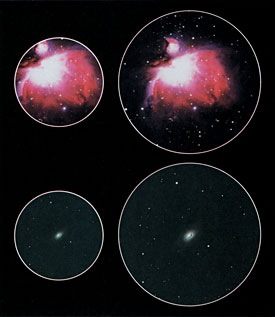
Choosing Your Astronomy Equipment
How to Choose Your Telescope Magnification
How high can you get? How low can you go? The answers depend on many factors that combine to give each telescope a useful magnitude range.

DIY: Astronomy Projects & Guidance
DIY Dew Heater
With just a little electrical know-how you can make an antidew heater that suits your scope.

My "Flapping Roof" Observatory
By day my observatory looks like an ordinary (if rather grandiose) garden shed. At night the roof sections go down and back up. They "flap" like a bird's wings.

DIY: Astronomy Projects & Guidance
Offsetting Your Secondary Mirror
The secondary-mirror offset is no doubt the most misunderstood aspect of collimation. Luckily you don't need to understand it to collimate your instrument.

My Place in the Dark
Twenty weekends and countless trips to the building-supplies store later, I'd done it — I had an observatory to call my own.

DIY: Astronomy Projects & Guidance
Accurate Polar Alignment with Your Telescope
Long-exposure astrophotography requires an accurately aligned equatorial mount.

Choosing Your Astronomy Equipment
A Pupil Primer: How Big Should a Telescope's Exit Pupil Be?
Image brightness, magnification, and why the old ideal of a 7-millimeter exit pupil is not so ideal at all.

Choosing Your Astronomy Equipment
Telescope Eyepiece Guide
A telescope is only as good as its eyepiece — and a good one can make a big difference. Here's a quick look at the different types of eyepieces available.

DIY: Astronomy Projects & Guidance
8 Backyard Observatory Mistakes to Avoid
Here are a few potential problems that you might not see on your blueprints.

Binocular Basics: Glossary of Binocular Terms
Exit pupils. Eye relief. Image stabilization. What matters most for astronomers? Our expert explains it all.

Collimation Tools
Three tools are commonly used to collimate Newtonian reflectors.
Equipment: Guides & Recommendations
Meade's RCX400: Raising the Bar
The 12-inch RCX400 telescope from Meade Instruments, shown on its field tripod.S&T photo by Craig Michael Utter. When Meade Instruments announced its new RCX400 line of catadioptric telescopes in early 2005, it created such a buzz in the astronomical community that I visited the company's Irvine, California, headquarters to look…
Equipment: Guides & Recommendations
S&T Test Reports: Telescopes
No matter what type of telescope you're looking for — refractor, reflector, or catadioptric; alt-azimuth, equatorial, or Go To — you'll find examples among the scopes reviewed here.

Equipment: Guides & Recommendations
S&T Test Reports: Binoculars
Almost any binocular can be used for astronomy, but if you really like viewing the heavens with both eyes, you'll check out our reviews of binoculars specially designed for stargazers.
Equipment: Guides & Recommendations
S&T Test Reports: Imagers
Digital cameras, inexpensive CCDs, and sensitive video systems are revolutionizing celestial photography by amateur astronomers.
Equipment: Guides & Recommendations
S&T Test Reports: Accessories
Getting the most out of your telescope often means adding filters, adapters, or other accessories to improve its optical or mechanical performance.
Equipment: Guides & Recommendations
How We Conduct S&T Test Reports
Reader surveys tell us that one of the main reasons you turn to Sky & Telescope each month is to learn about new astronomical products. Thus we would like to describe the mission of S&T Test Report and the ground rules we've adopted for reviewing equipment. Most of these policies…
Equipment: Guides & Recommendations
Thermal Boundary Layers in Newtonian Reflectors
Assessing your telescope's state of cooling is the first step on the road to optimal performance.
